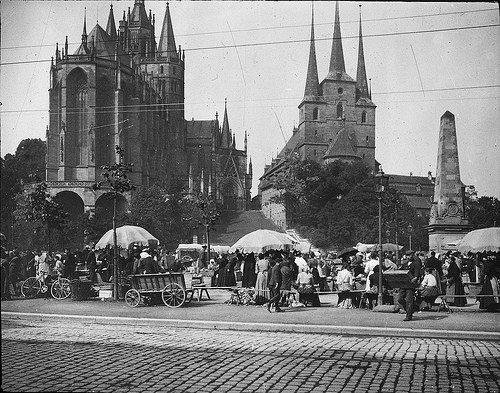| LEFT | 30.4% |
| AfD | 23.5% |
| CDU | 22.1% |
| SPD | 8.1% |
| GREENS | 5.1% |
| FDP | 5.1% |
Source: FGW projection, 8:10pm
Why waste my life writing lengthy books that no-one is going to read? Why go through the pain of peer review? Why, in fact, wait for the actual election results to come in? So here is my list on hot takes on the Thuringia state election.
- Everyone is talking about the AfD, but the real story of this election is the Left. Bodo Ramelow was the first member of the Left to become Minister President of a federal state. His red-red-green coalition was defeated, but only because his partners lost electoral support. The Left’s vote share actually increased a bit so that for the first time since 1990, the Left has become the strongest party in a Land election. Ramelow himself is even more popular than his party and may be able to continue, either as a caretaker/minority Minister President or at the helm of some new (and very complicated) coalition.
- Single-digit SPD results are almost normal now. The SPD has always struggled in Thuringia. Now, the SPD has once more dipped into single-digit territory (after Bavaria and Saxony). A few years ago, that would have been unthinkable. Now, it’s not really a huge surprise.
- Germany is not yet the Netherlands, but we are getting there. Journalists and pundits still talk about the “Volksparteien” – the CDU/CSU-SPD duopoly – as if this were the normal state of affairs in Germany. But it seems unlikely that were are going back to a two-dominant-and-some-minor-parties arrangement any time soon. If the FDP makes it past the electoral threshold, there will be six parties in the new state parliament. Just like in the Bundestag, the Bavarian state parliament, and the Landtag in Brandenburg, to name a few. For the time being, fragmentation and volatility are the new normal.
- The Green Wave has not reached Thuringia. Nationwide, the Greens are still the second party and poll between 20 and 25 per cent. They have made some inroads in the eastern states, where they have struggled for most of the last three decades. Opinion polls looked moderately good for them, but in reality, they came dangerously close to the threshold. In fact, it is still not clear whether they will make into parliament. This does not mean that the wave has ended today. Thuringia is a small state that is in no way representative and was always a difficult arena for them (think lots of wood and history, few universities/cities).
- The most extreme flavour of the AfD remains popular in the (south-)east. It’s not a secret that the AfD is much stronger in the eastern states than they are in the west. Currently, a result in the 20s seems to be normal in the southern part of the former GDR, with some pockets were they go even beyond 30 per cent. The result in Thuringia is well within that range. The interesting point is that the AfD in Thuringia is led by a man who pushes the envelope of being a right-wing populist, a man whose rhetoric, policies and associates are more in line with traditional German right-wing extremism. Höcke has voiced support for rank-and-file members of the NPD when the AfD was still a polite bunch of Eurosceptics. He has spread racist tropes about Africans, has marched with Neo-Nazis and campaigned for a U-turn in Germany’s approach to its traumatic past. He infamously called the Holocaust memorial in Berlin a “monument of shame in the heart of our capital”. And yet, only days after a Christchurch-style attack on a synagogue, Höcke’s AfD won about a quarter of the vote. Some may have cast their vote in spite of him (he was not exactly popular in pre-election surveys), but at least fraction must have known what they were doing. Which is a very scary notion.


RT @kai_arzheimer: To get an idea what this means, have a look at #5 in this old post https://t.co/O95zgjanRq